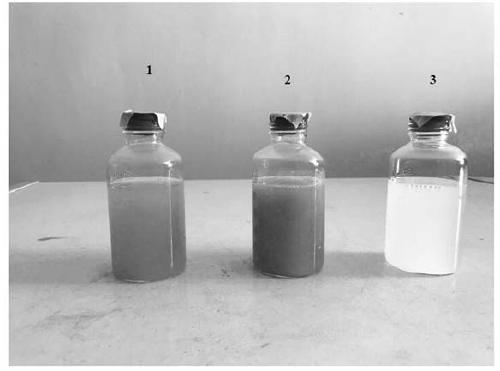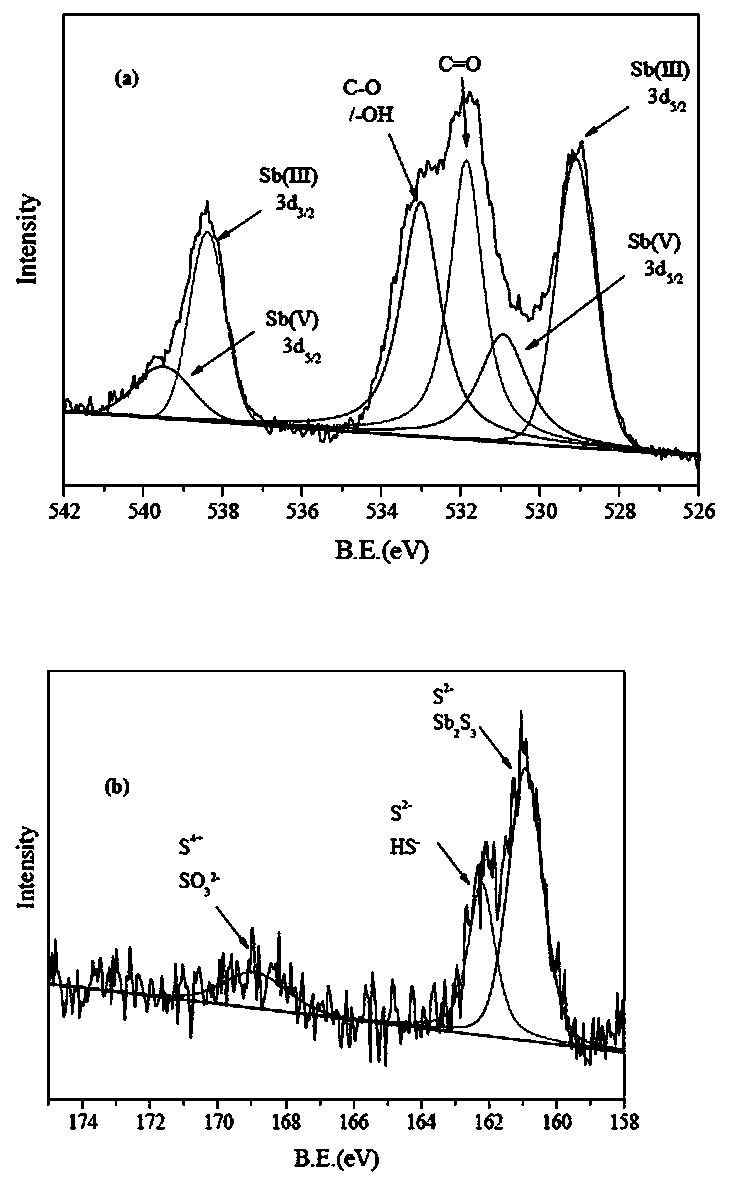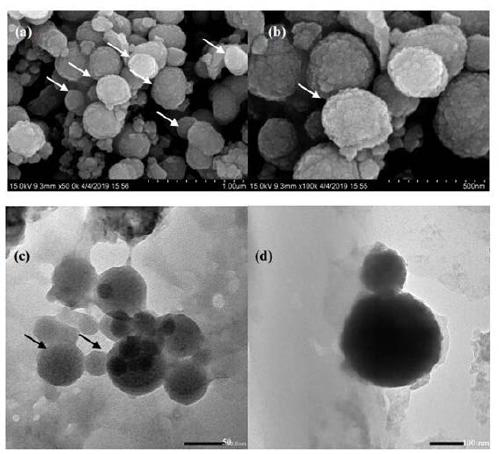Microorganism for preparing broccoli-shaped antimony sulfide and application of microorganism
A technology of broccoli and microorganisms, which is applied in the field of microorganisms for preparing broccoli-like antimony sulfide, can solve the problems of difficult reduction and high toxicity, and achieves the effects of accelerated photodegradation, environmental friendliness and low technical cost.
- Summary
- Abstract
- Description
- Claims
- Application Information
AI Technical Summary
Problems solved by technology
Method used
Image
Examples
Embodiment 1
[0034] The above obtained strain X3 (0.5 g / L dry weight), Sb(V) (0.1 mM) and 1 mM S 2 o 3 2- (or SO 3 2- ) in 100 mL inorganic salt medium, the salinity was 2%, the pH was adjusted to 7, then 18 mM sodium lactate was added, nitrogen was exposed for 15 min, at 30 o In the anaerobic incubator of C, the reaction was protected from light for 5 days, and the color change can be found in figure 1 .
[0035] The inorganic salt medium is per liter, 1 g NH 4 Cl, 0.8 g Na 2 HPO 4 , 0.2 g KH 2 PO 4 , 0.2 gMgCl 2 ·7H 2 O, 0.1 g CaCl 2 2H 2 O, 20 g NaCl, the balance is deionized water.
[0036] Depend on figure 1 It can be seen that X3 can turn orange-yellow in the presence of antimony and thiosulfate or sulfite, which is verified as Sb 2 S 3 , the darker the color, the better the restoration effect. The results show that in the current reaction system, the reaction system with sulfite addition is lighter than the reaction system with thiosulfate addition at the same ti...
Embodiment 2
[0038] The obtained strain X3 (0.5 g / L), Sb(V) (0.2 mM) and 1 mM S 2 o 3 2- Mix evenly in 100 mL of inorganic salt medium, set the salinity to 2%, adjust the pH to 7, then add 18 mM sodium lactate, aerate with nitrogen for 15 min, at 30 o React in an anaerobic incubator in C for 5 days in the dark, centrifuge the obtained mixture (10000 rpm, 5 min), collect the precipitate and place it in deionized water for ultrasonic treatment for 1 h, after centrifugation, wash the precipitate with 1% anionic surfactant Sodium dialkylsulfonate resuspended, 90 o C hot water bath for 45 min, and then centrifuge again (10000 rpm, 10 min) to freeze-dry the precipitate, which is Sb 2 S 3 (see figure 2 ).
[0039] The inorganic salt medium is per liter, 1 g NH 4 Cl, 0.8 g Na 2 HPO 4 , 0.2 g KH 2 PO 4 , 0.2 gMgCl 2 ·7H 2 O, 0.1 g CaCl 2 2H 2 O, 20 g NaCl, the balance is deionized water.
[0040] Depend on figure 2 Through the verification of X-ray diffraction energy spectrum, i...
Embodiment 3
[0043] The obtained strain X3 (0.7 g / L), Sb(V) (1 mM) and 2 mM SO 3 2- Mix well in 100 mL of inorganic salt medium, adjust the pH to 7.2 with a salinity of 3%, then add 18 mM glucose, aerate with nitrogen for 15 min, at 30 o The anaerobic incubator in C was reacted in the dark for 7 days, and the obtained mixture was centrifuged (10000 rpm, 5 min), and the precipitate was placed in deionized water for ultrasonic treatment for 1 h. After centrifugation, the precipitate was treated with 1.5% anionic surfactant Sodium dialkylsulfonate resuspended, 95 o C hot water bath for 60 min, and then centrifuge again (10000 rpm, 10 min) to freeze-dry the precipitate, which is Sb 2 S 3 .
[0044] Use energy spectrometer to verify the elements contained in the obtained material. According to the results of energy spectrum, the material is mainly composed of Sb and S elements, and there are some residual salts (such as Na, Cl, P) and biomass elements (such as C, N, O, P) ( Figure 4 ). ...
PUM
 Login to View More
Login to View More Abstract
Description
Claims
Application Information
 Login to View More
Login to View More - R&D
- Intellectual Property
- Life Sciences
- Materials
- Tech Scout
- Unparalleled Data Quality
- Higher Quality Content
- 60% Fewer Hallucinations
Browse by: Latest US Patents, China's latest patents, Technical Efficacy Thesaurus, Application Domain, Technology Topic, Popular Technical Reports.
© 2025 PatSnap. All rights reserved.Legal|Privacy policy|Modern Slavery Act Transparency Statement|Sitemap|About US| Contact US: help@patsnap.com



